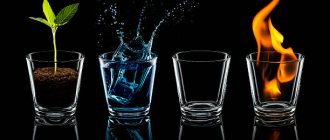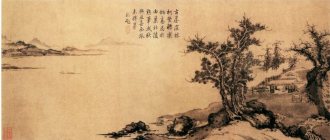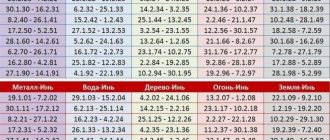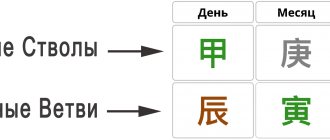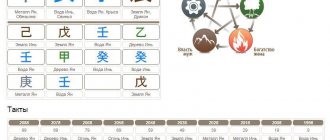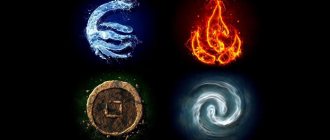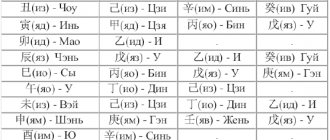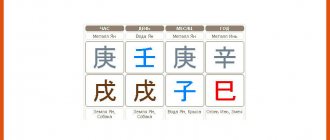Pentagram of the elements.
Elements, elements
- in magic: the four primary elements (Fire, Water, Air and Earth), understood as the four kingdoms, or divisions, of the natural world. The fifth element, Spirit, binds together and controls the four natural elements, which is graphically represented in the symbol of the pentagram. The elements are also considered as parts of nature or human nature, which are symbolically related to these elements in their properties - depth, lightness, fervor, hardness, and so on.
Elements or elements correspond to elemental or elemental weapons: Rod of Fire, Chalice of Water, Dagger of Air and Pentacle of Earth. In Golden Dawn ceremonies, symbols of the four elements are placed on the altar: a lamp (Fire), a cup of wine (Water), a rose or incense (Air), and a dish of bread and salt (Earth).
Elements in science and magic
The doctrine of the four primary elements, or elements: fire, water, air and earth, is one of the most ancient magical teachings. “Just as all words are composed of letters, so all matter is composed of four elements.”
, wrote the Jewish theologian Philo of Alexandria (c. 25 BC - c. 50 AD).
However, this teaching itself arose long before these words were uttered. Its founder is considered to be the Greek philosopher, magician and poet Empedocles (483-423 BC), according to whose theory, outlined in his poem “On Nature,” the four elements form the “roots” of things and the universe. They fill all space and are in constant motion, moving, mixing and separating. They are unchanging and eternal. All things seem to be made up of these elements, Empedocles believed, “just like a wall is made of bricks and stones
.
A hundred years later, another great Greek philosopher, Aristotle (384-321 BC), argued that nature consists of four elements: fire, water, air and earth, each of which is characterized by a combination of two qualities - active and passive.
The combination of these four elements, or elements, in various quantitative proportions forms complex bodies in which these elements interpenetrate and dissolve into each other. In addition to the listed elements, according to Aristotle, there is also a fifth element - ether, which fills all cosmic space and from which the celestial bodies are composed. Its nature is fundamentally different from the other four elements. Ether is unchangeable and perfect. In magic, the ether is usually identified with the spirit that animates and controls all four elements.
Each element has its own unique properties and characteristics, which in magic and alchemy, as well as in the ancient traditions of medicine, act on both the physical and spiritual levels. In addition, there are entities called elementals; they live in every element and embody its essence.
The element associations are:
Earth: physical body; health; what a person has, for example money, time, energy; thoroughness; abundance. Water: emotions; intuition; subconscious; revitalizing fluids and forces; rhythms of nature. Air: mental effort; thought; rationality; communication; intellectual actions; solutions. Fire: action; study; cleansing
According to Henry Cornelius Agrippa's Three Books of Occult Philosophy, these four elements exist everywhere in the universe, even in spirits and angels, and can be divided into three types. On Earth they are mixed with each other and are not found in pure form; in stars, on the contrary, they exist in their pure form. The third type is complex elements; they are changeable and through them all transformations occur.
In Kabbalistic thought, these four elements are represented by the four rivers that flow from the Garden of Eden described in the Book of Genesis. These four elements are associated with the four fixed signs of the zodiac, the four apostles of the New Testament and the four cardinal directions:
Side: north Zodiac sign: Taurus Element: Earth Matthew
Side: West Zodiac sign: Scorpio Element: Water John
Side: east Zodiac sign: Aquarius Element: Air Mark
Side: Zodiac sign: Leo Element: Fire
Paracelsus distinguished two substances: Adamic and non-Adamic. Adam's flesh, from which all humans are created, is composed of four elements, each of which governs different aspects of health and essence. The body has a physical or mineral component, a vegetable or moist component, a fiery (or warm) or moving component, and finally an airy or intellectual component.
A modern magician is undoubtedly familiar with the periodic table and the ideas of chemists about elements as “the building blocks of the universe.” He knows that water is the physical expression of the formula H2O, and fire is cold plasma or, according to a more detailed scientific definition, “a luminous hot zone of interaction of vapors, gases or products of thermal decomposition of a flammable substance with oxygen.” But in the theory of magic, the elements/elements are not chemical elements, but first principles, the original threads, the combination of which weaves the world. It is the fifth element, Ether or Spirit, that breathes life into them. Working with the four elements is one of the most important foundations of practical magic.
Emblematics
In Western art: water was depicted as an overturned jug or figures of the gods of the sea and rivers; air - the figure of Juno, sometimes flying with shackles on her hands and feet, sometimes a woman with a chameleon in her hand; fire - the Phoenix, the figure of Vulcan, as well as a woman with fiery hair or lightning in her hand; the earth - an allegorical figure of the Mother with symbols of fertility in her hands; as well as the tower-shaped crown of Cybele. The four elements can be represented either as conventional faceless female figures, distinguishable only by their attributes, or, especially in the 16th century, as the gods and goddesses of classical antiquity. They can be found on the frescoes and ceilings of Renaissance buildings in Italy, and also as individual paintings that make up a four-part cycle, although they are often scattered across different galleries. Northern European genre artists and authors of files galantes of the 17th-18th centuries gave the names of these four elements to cycles of paintings depicting young men and women engaged in some corresponding activity. The Earth, like a woman, has many attributes belonging to the goddesses of fertility: the horn of plenty and the SERPENT, SCORPIO of the Roman goddess of agriculture, the Earth-Mother (Latin - Tellus Mater). She can breastfeed one or two children, like Ops, the Roman goddess of the harvest. The crown in the form of a wall with turrets was taken from CYBEL - the ancient Phrygian Earth-Mother. Genre scenes depict various agricultural works - picking fruits, plowing the ground, watering the beds, and so on. Air was the kingdom of Juno, and therefore it can be represented by this goddess with her PEACOCK. Or she is depicted floating in the air, with an anvil tied to each of her legs - this is how Jupiter punished his wife for disobedience (Iliad, 15:18-21). She may be surrounded by BIRDS - a symbol of air. Air is personified by a woman holding a CHAMELEON - a creature that, according to Pliny (Natural History, 8:33), does not eat or drink, but lives on air. Boys and girls of the 18th century are depicted outdoors playing with toy windmills or blowing soap bubbles. Fire. Takes the form of a woman with her head on fire, she holds a BEACH OF LIGHTNING. Or on her head instead of a hairstyle is a Phoenix bird, engulfed in fire, which is her symbol. VULCAN, that smith of the gods, with hammer in hand, likewise personifies fire. He can be depicted at work - forging the armor of Aeneas, while Venus and Cupid watch him. Water is personified by the river god with his traditional attribute - an inverted URN from which water flows, or by NEPTUNE and his many companions - NEWTS and NEREIDS, accompanied by DOLPHINS, HIPPOCAMPS and sea centaurs. They appear with this meaning in many paintings with a marine theme. Genre artists depict fishermen sitting on the bank of a river or in a boat. See also FOUR TEMPERAMENTS.
Elemental Correspondences
Modern Western magicians David Rankine and Sorita d'Este provide in their book “Practical Magic of the Elements” [1] the following table of correspondences of magical intentions and elements, which may be useful to you in practical work.
Table of Magical Intentions
| Intention | Elements |
| Astral travel | Water |
| Unconscious (find access) | Water |
| Business (achieve prosperity) | Air |
| Welfare (increase) | Fire; Earth |
| Future (find out) | Air, Water |
| Influence (increase) | Air |
| Lust (satisfy) | Earth; Fire |
| healing | Fire, Air |
| Public speaking (successful) | Air |
| Harmony (develop) | Fire, Air |
| Flexibility (develop) | Air |
| Anger (control) | Fire |
| Money (purchase) | Fire |
| Duty (fulfill) | Earth |
| Home (protect) | Earth |
| Friendship (develop) | Earth |
| Law (relations with) | Air; Earth |
| Health (strengthen) | Air |
| Knowledge (increase) | Air |
| Illusions (induce) | Water |
| Illusions (dispel) | Earth |
| Property (return lost) | Air |
| Career | Fire, Air |
| Beauty (develop) | Earth |
| Leadership abilities (develop) | Fire |
| Love (to gain or strengthen) | Earth; Water |
| World (install) | Fire; Air |
| Musical abilities (acquired or developed) | Air |
| Communication skills (develop) | Earth; Air |
| Charm (purchase) | Water |
| Communication (facilitate) | Air |
| Responsibility (accept) | Air; Water |
| Memory (improve) | Air |
| Fertility (purchase) | Earth |
| Promotion (get) | Fire; Air |
| Patronage (purchase) | Fire |
| Honors (to achieve) | Air |
| Truth (to find out or report) | Air |
| Practicality (develop) | Earth |
| Teaching abilities (develop) | Earth; Air |
| Attractiveness (enhance) | Earth |
| Travel (safe) | Air (by air), Water (by sea), Land (by land) |
| Equilibrium (set) | Earth |
| Discord (cause) | Fire |
| Discord (prevent) | Air |
| Childbirth (safe) | Water |
| Sexual desire (weaken) | Earth |
| Sexual desire (increase) | Fire |
| Strength (develop) | Fire; Earth |
| Willpower (strengthen) | Fire |
| Dreams (induce and remember) | Water, Air |
| Passion (ignite) | Fire; Earth |
| Fear (eliminate) | Fire |
| Creative abilities (develop) | Fire, Air |
| Patience (develop) | Earth |
| Self-confidence (acquire) | Earth |
| Self-confidence (strengthen) | Earth |
| Luck (purchase) | Air |
| Pleasure (get) | Earth |
| Courage (develop) | Fire |
| Determination (develop) | Fire, Air |
| Sense of humor (develop) | Air |
| Exams (successfully pass) | Air |
| Energy (develop) | Fire |
| Energy (accumulate) | Fire |
| Enthusiasm (cause) | Fire |
| Ethical principles (develop) | Air |
| clairvoyance (develop) | Water |
Of course, this table of correspondences is quite arbitrary and some correspondences may vary from tradition to tradition, from school to school.
Basic qualities of the elements
Qualities of the elements
Each element is a combination of two basic qualities. In total, there are four qualities: heat, cold, dryness and humidity. They make up two pairs of opposites: heat-cold and dry-humidity.
Heat is considered akin to dryness, and cold to moisture.
- The qualities of Fire
are
warmth and dryness
. - Qualities of Water
-
cold and wet
. - Air
qualities -
heat and humidity
. - The qualities of the Earth
are
cold and dry
.
Thus, Fire and Water consist of qualities related to each other (and on this basis are considered “pure” elements), and Air and Earth are composed of qualities that do not have direct affinity (and on this basis they are considered “mixed”).
Astronomy/logy
Natural phenomena became the basis of the occult sciences, especially astrology, which divides the signs of the zodiac into four elements: Fire, a symbol of instinctive and subconscious biological dynamism: Aries, Leo, Sagittarius. Air, the tendency of the conscious to impressions: Gemini, Libra, Aquarius. Earth, activities aimed at implementation, the wealth of the human subconscious: Taurus, Virgo, Capricorn. Water, passivity and receptivity: Cancer, Scorpio, Pisces.
Symbols and correspondences of elements
see more details
: Fire, Water, Air, Earth, Spirit
Fire
—
- The symbol
is a triangle with its apex facing upward, graphically similar to a tongue of flame. - Fire
is a hot and dry, active, “masculine” element. - Basic physical form
: combustion of any substance, accompanied by the release of heat and light. - Esoteric meaning
: the force operating at the center of all things, and the driving force of alchemical transmutation. The great divine energy of the Father is the power of the “seed” of the universe. - Key words
: will, energy, inspiration. - Properties
: hot, bright, light, active, energetic, fast, determined, strong-willed, creative, independent, focused on new things, expansive, ardent, passionate, enthusiastic, uncontrollable, impulsive, aggressive, furious, hot-tempered. - Temperament
: choleric. - Virtue
: courage, daring. - Side of the world
: south. - Time of year
: summer. - Time of day
: noon. - Magic weapon
: wand. - Color
: red.
Water
—
- The symbol
is a triangle with its apex facing downwards and is associated with water, which always flows downwards under the influence of gravity. - Water
is cold and wet, passive, “feminine” element. - Basic physical form
: in nature, water - a combination of oxygen and hydrogen molecules (H2O) - exists in three states: liquid (water itself), solid (ice) and gaseous (water vapor). However, in an esoteric sense, the element of Water in its pure form includes only H2O in the liquid state, as well as - by analogy with the basic physical properties of water - all other liquid substances. - Esoteric meaning
: the prototype of all matter, the womb of life, a symbol of motherhood, the Great Mother, as well as the great source of wisdom hidden in the unconscious. - Key words
: feelings, intuition, subconscious, imagination. - Properties
: passive, receptive, fluid, flexible, smooth, emotional, impressionable, secretive, dreamy, creative, maintaining internal constancy despite external variability and pliability, irrational, uncertain, indecisive, sentimental. - Temperament
: phlegmatic. - Virtue
: desire. - Side of the world
: west. - Time of year
: autumn. - Time of day
: evening. - Magic weapon
: bowl. - Color
: blue
Air
—
- The symbol
is a triangle facing upward, crossed out by a line, indicating the lightness of the air and its position “above”, and the horizontal line symbolizes the clouds that separate the lower layers of air from the upper ones. - Air
is a hot and humid, active, “masculine” element. - ' Basic physical form
: a mixture of gases that make up the Earth's atmosphere. In an esoteric sense, the element of Air also includes gaseous states of any substances. - Esoteric meaning
: life-giving breath, speech, Logos. - Key words
: thought, mind, intelligence, information, communication (primarily speech). - Properties
: volatile, light, ethereal, mobile, pervasive, abstract, intellectual, sociable, analytical, erudite, versatile, inquisitive, mediator, flighty, fickle, absent-minded, frivolous, talkative, superficial, unreliable, overly rational. - Temperament
: sanguine. - Virtue
: knowledge. - Side of the world
: east. - Time of year
: spring. - Time of day
: morning. - Magic weapon
: dagger. - color
.
Earth
—
- The symbol
is a triangle facing down, crossed out by a line, symbolizing the heaviness of the earth and its position “below”, and the horizontal line denotes the earth’s surface. - Earth
is a cold and dry, passive, “feminine” element. - Basic physical form:
earth's soils and rocks, as well as any solid substance. - Esoteric meaning
: physical, material universe, productivity, growth, regeneration, abundance. - Key words
: body, physical form. - Properties
: material, solid, dense, stable, concrete, clear, formed, structured, slow, solid, stable, unchanging, practical, purposeful, definite, reliable, cautious, sensible, overly materialistic and pragmatic, ponderous, inert, inert. - Temperament
: melancholic. - Virtue
: silence. - Side of the world
: north. - Season
: winter. - Time of day
: midnight. - Magic weapon
: pentacle (disk). - Color
: four sectors of a circle, painted in four colors - olive, lemon, reddish brown and black.
Spirit
—
Spirit (or Ether)
- the fifth element (quintessence), which controls the four natural elements, separating them from each other, and at the same time, connecting them all into a single harmonious and balanced system. The top of the pentagram of the elements.
Spirit
- the eternal and unchanging source of all energy, from which other elements are born and in which they dissolve, and most importantly, which controls them.
- The symbol
is the wheel of the spirit, uniting four triangles of elements. - Cardinal direction
: center. - Magic weapon
: Lamp. - Colour
: brilliant white.
Antiquity
In antiquity, a paired primary quality (stoicheia) of activity and passivity was distinguished from which the active principles “dry” and “wet” and the passive principles “cold” and “warm” emanate. From their combinations the actual elements are formed: “dry” and “cold” form earth, “dry” and “warm” - fire, “wet” and “warm” - air, “wet” and “cold” - water.
Primary qualities - active passive Origins - dry - wet cold - earth - air warm - fire - water
In Greco-Roman symbolism, the elements are usually personified by female figures or deities, and from these bases come numerous series of analogies. Gods - Animals - Objects - Season - Liquor - Organ - Color - Temperament - Body (geometric)
Water - Neptune - Nereids, dolphin, horse - overturned or leaking vase - winter - bodily mucus - brain - white color - phlegmatic - icosahedron - triangle
Fire - Vulcan - woman whose head is on fire, phoenix - summer - (yellow) bile - liver - fiery colors - choleric - tetrahedron
Earth - fertility goddesses - tower-crowned head of Cybele, chthonic snake, scorpio - cornucopia - autumn - black bile - spleen - lead color - melancholic - cube - square
Air - Juno and the peacock, Juno flying, with bellows suspended from her feet - peacock, chameleon (thought to feed on air) - spring - blood - heart - bright colors - sanguine -
Ancient theories of healing, which have survived in whole or in part to the present day, proclaimed as the main goal of healing the harmonization of these components in a person, so that none of them received absolute superiority, damaging their optimal balance. A curious thing is the symbolic comparison of the “four elements” with geometric solids in Plato’s dialogue “Timaeus”, which says:
“We, of course, attribute to the earth the form of a cube: after all, of all four genera, it is the earth that is most motionless and suitable for the formation of bodies, and therefore it is necessary for it to have the most stable bases... the least mobile [triangle taken as the base]... we will assign to water (icosahedron), . the most mobile one is for fire (tetrahedron), and the middle one is for air, and finally, the most acute-angled body is for fire, the next one is for air, and the third is for water.” Plato, Timaeus, 55e-56a.
The dodecahedron symbolizes the Universe.
Formulas of elements in magic
In the Western magical tradition, various magical formulas are considered to be an expression of the totality of the elements. The most famous of them is the Tetragrammaton, the letters of which - Yod - - Vav - He (final) are attributed to the four elements. When adding to them the fifth letter - Shin, which symbolizes the Spirit, the Pentagrammaton is obtained, which in Hermetic Kabbalah correlates with the name Yeshua, that is, Jesus.
In the commentary to the Book of Spiritual Capricorn C.S. Johnson points out that the four elements also correspond to the FIAT formula as an anogram of the Latin words “air” - flatus, “fire” - ignis, “water” - aqua, “earth” - terra.
Also in Sefer Sephiroth, Aleister Crowley correlates the formula AMTeSh (that is, Aleph-Mem-Tav-Shin) with the elements. Aleph - air, Mem - Water, Shin - Fire (or Spirit), Tav - Earth. In traditional Jewish Kabbalah, three primordial elements are considered - Fire, corresponding to the letter Shin, Vazduh - Aleph and Water - Mem. Earth is considered a mixture of these elements and is not assigned a separate letter. However, in the Hermetic Kabbalah the letter Tav is attributed to the Earth, which thus has a double correspondence - Earth and Saturn, as well as the letters Shin, corresponding to Fire and Spirit.
Earth
Earth is the element that creates the matter of this world. The element earth is directly related to planet Earth. Everything we have in this world we received from our planet. And everything we have will also return back to the Earth, including our physical body. The Earth is a Yin element, just like our planet Earth. The Earth element corresponds to the Muladhara and Vishuddha chakra.
Earth is the world of information, which is primary for the world of forms (the world of Manipura chakra). This is the element of order, and it is order that rules in the world of information. The earth is what forms structures, the crystal lattice of any substance, obeys some invisible law, according to which this substance has just such a crystal lattice. And this invisible law is the element Earth.
The Earth interacts harmoniously with the elements of Fire and Water, but it is much more difficult for it to interact with the element of Air. The element Earth corresponds to winter. The most severe frosts are the greatest manifestation of the elements in our world.
Magic in the understanding of the majority is precisely the quality of the earth. Since it is the earth that is responsible for operating forms, including subtly material ones. Learning earthbending is the most difficult for most.
The people of the Earth are those who you can rely on, they stand firmly on their feet. They are unhurried, stable and resilient, they know what they are trying to achieve, and if they take on something, they do everything thoroughly. They do not get along with people very easily, they are stubborn, and often petty. It is very difficult for them to forget someone else's insult, and they have a strange combination of stinginess and generosity. At the same time, they are reliable friends and helpers. They are generous with friends and are always happy to share what they have. These are reliable defenders who always keep their word.
We can say that the main property of the element Earth is the ability to hold. Moreover, it doesn’t matter what to keep, money, information, structure or form. These people slowly comprehend something new for themselves, but if they understand it, it will last for a long time. They don't like change because they don't know how to react to it. The qualities of the people of Earth are thoroughness, reliability, strength, efficiency, painstakingness and perseverance.
The magical instrument of the Earth element is the Pentacle.
Source
Working with the Elements
One of the most important components of magical practices is working with the elements.
Since, according to esoteric views, a person himself consists of four elements and the element of Spirit that crowns them, then, having studied their qualities and abilities, he gets the opportunity to recognize the presence of the elements in different parts of his own essence - from the physical to the spiritual, from the mental to the emotional. In Liber Librae. The Book of Libra” Aleister Crowley writes: “Be nimble and active like the Sylphs, but beware of frivolity and inconstancy;
be energetic and strong, like the Salamanders, but beware of irritability and cruelty; be flexible and receptive to images, like Ondine, but beware of idleness and fickleness; be hardworking and patient like the Dwarves, but avoid rudeness and stinginess. Thus, you will gradually develop the powers of your soul and become worthy of commanding the Spirits of the Elements” [2].
Learning to work with the forces of the elements is extremely important.
Only by completing this task can the magician break free from the Malkuth sephira and begin moving up the Tree of Life. As the modern Thelemic author Geoffrey Cornelius writes: “on the one hand, they can help the Neophyte climb to the top of the Sacred Mountain;
on the other hand, they can plunge him into the abyss. At the same time, it is impossible to strengthen the good component of the elements without strengthening the harmful one: the more spiritual the applicant becomes, the more fiercely the elements of his own nature rebel against him, trying to drag him back into the darkness and sorrow of the Earth, clothed, as a rule, in his desires and fears or religious beliefs" [3].
As the founder of the Hasidic Chabad movement Shneur-Zalman (1745-1813) notes in his book Tanya, anger and pride come from the element of fire, striving upward; the desire for pleasure comes from the element of water, for from water grow all kinds of things that give pleasure; senseless fun, mockery, boasting and empty activities - from the element of air; laziness and sadness come from the earth element.
The main tool for controlling the forces of the elements is will (in the pentagram it is symbolized by the fifth corner - Spirit). Controlling the elements by the power of one's will develops as experience accumulates, and the more actively the magician applies it in practice, the deeper his understanding of the elements becomes.
To work with the four elements, you can use the Greater Ritual of the Pentagram, the Lesser Ritual of the Pentagram and other practices.
Aleister Crowley offers the following poem in his Book of Thoth to address the elements as the basis of the numerical arcana of the Tarot:
Invocation (oath written during morning meditation)
In the name of our kinship, Aiwaz, breathe into me the Holy Seed - the high heat of the creative Fire! Transform yourself to match Yourself and again cover my Living flesh with the magic of the divine Earth! Dissolve my sacred ecstasy in Your ecstasy, So that with the net of death I may catch and save the Soul of the Waters! And illuminate my mind with the thought that it will reach the heights: The air current will carry it to Unity and into Nothingness! And my Essence, freed from the “I,” will find the “I” in a marriage embrace between Itself and the Spirit of Existence [4].
Occultism
Natural phenomena became the basis of the occult sciences, especially astrology, which divides the signs of the zodiac into four elements: In the works of the Rosicrucians one can find the doctrine of the secrets of the four kingdoms, especially known, at least to modern occultists, are the works of Count Cabali (under this pseudonym), filled with Gallic humor. the name of a real-life wise knight from eastern Germany or even Hungary is hidden). Let us think about the fact that without the myths collected by alchemists, followers of Paracelsus and Rosicrucians, the work of the romantics would have been impossible in general - they populated their poetry, music and painting with the spirits of nature with whom their heroes met. Thus, they brought back to life the tales and information collected in popular beliefs.

